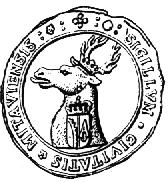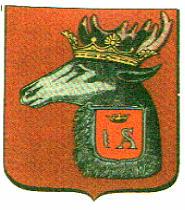Jelgava: Difference between revisions
Jump to navigation
Jump to search
Knorrepoes (talk | contribs) No edit summary |
Knorrepoes (talk | contribs) m (Text replacement - "{|width="100%" style="color:black; background-color:#ffffcc;" |width="15%"|50 px|left |width="70%" align="center" |'''Heraldry of the World<br/>Civic heraldry of Latvia - Latvias ģerboņi/Latvijas heraldika ''' |width="15%"|50 px|right |}<seo title="ģerboņis, heraldika" /> " to "{{latvia}}") |
||
| Line 1: | Line 1: | ||
{ | {{latvia}} | ||
''' JELGAVA''' | ''' JELGAVA''' | ||
Revision as of 04:59, 12 July 2015
Template:Latvia JELGAVA
Region : Zemgale
Official blazon
Purpura laukā aļņa galva dabiskā krāsā, uz kakla valsts mazais ģerbonis (bez zvaigznēm).
Origin/meaning
The arms were granted on October 31, 1925.
Jelgava, then called Mitau in German, acquired its city rights and coat of arms, depicting the crowned stag's head on a red background in 1573.
| The seal from the 18th century |
The city, later called Mitava in Russian, used the same arms with slightly different design during the rule of Russian Empire (see below).
In 1925 the small shield was replaced by the National Arms. These arms were confirmed after the second independence, in 1998.
Contact and Support
Partners:
Your logo here ?
Contact us
© since 1995, Heraldry of the World, Ralf Hartemink 
Index of the site
Literature : Latvias ģerboņi, 2008












